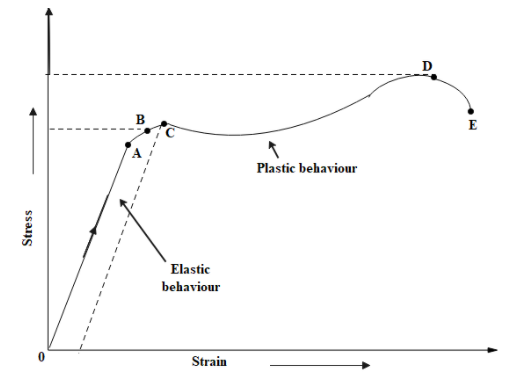
Hooke’s law holds good up to
A. Plastic point
B. Limit of proportionality
C. Breaking point
D. None of these
Answer
546k+ views
Hint:A spring is said to be in its natural length when no force is applied on the spring. When some force is applied to the spring, it compresses or elongates according to the direction of the applied force. The amount of compression or elongation experienced by the spring is linearly dependent on the applied force within some reasonable tolerance. Hence, we shall not analyze the Hooke’s law.
Complete solution:
The Hooke’s law says that the restoring force experienced by a spring is directly proportional to the extension or compression of a spring. It is expressed as:
${{F}_{restoring}}=-kx$
Where,
${{F}_{restoring}}=$ restoring force acting on the spring
$k=$ spring constant
$x=$ displacement of spring from its natural length
The negative sign here indicates that the restoring force acts in the direction opposite to the displacement of the spring.
Given below is the graph of Hooke’s law experiment. The various points on the graph are as follows:
$A=$ Limit of proportionality
$B=$ Elastic limit or yield point
$E=$ fracture point
It can be seen that only until point A, stress is linear with strain and the material portrays elastic behaviour. Therefore, Hooke’s law holds good only till the limit of proportionality (point A).

Therefore, the correct option is (B) Limit of proportionality.
Note:
After the spring loses its elastic behaviour and starts showing the plastic behaviour, it cannot be restored back to its natural length. The changes made in the orientation of the spring lasts forever. If the force applied on the spring is immense and crosses the fracture point (point E on the graph), then the spring finally breaks.
Complete solution:
The Hooke’s law says that the restoring force experienced by a spring is directly proportional to the extension or compression of a spring. It is expressed as:
${{F}_{restoring}}=-kx$
Where,
${{F}_{restoring}}=$ restoring force acting on the spring
$k=$ spring constant
$x=$ displacement of spring from its natural length
The negative sign here indicates that the restoring force acts in the direction opposite to the displacement of the spring.
Given below is the graph of Hooke’s law experiment. The various points on the graph are as follows:
$A=$ Limit of proportionality
$B=$ Elastic limit or yield point
$E=$ fracture point
It can be seen that only until point A, stress is linear with strain and the material portrays elastic behaviour. Therefore, Hooke’s law holds good only till the limit of proportionality (point A).

Therefore, the correct option is (B) Limit of proportionality.
Note:
After the spring loses its elastic behaviour and starts showing the plastic behaviour, it cannot be restored back to its natural length. The changes made in the orientation of the spring lasts forever. If the force applied on the spring is immense and crosses the fracture point (point E on the graph), then the spring finally breaks.
Recently Updated Pages
Master Class 12 English: Engaging Questions & Answers for Success

Master Class 12 Business Studies: Engaging Questions & Answers for Success

Master Class 12 Economics: Engaging Questions & Answers for Success

Master Class 12 Social Science: Engaging Questions & Answers for Success

Master Class 12 Maths: Engaging Questions & Answers for Success

Master Class 12 Chemistry: Engaging Questions & Answers for Success

Trending doubts
What are the major means of transport Explain each class 12 social science CBSE

Which are the Top 10 Largest Countries of the World?

Draw a labelled sketch of the human eye class 12 physics CBSE

Explain sex determination in humans with line diag class 12 biology CBSE

Explain sex determination in humans with the help of class 12 biology CBSE

Differentiate between homogeneous and heterogeneous class 12 chemistry CBSE




